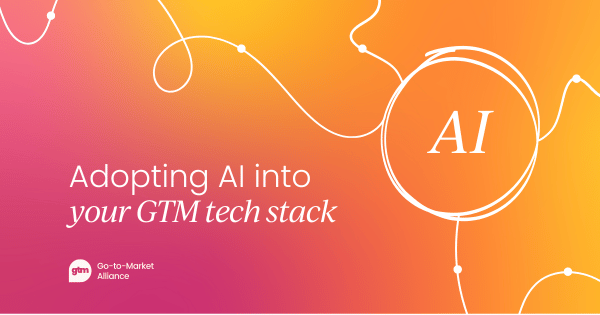AI is making huge waves in the GTM landscape. But once you’ve implemented your tool of choice and rolled out new processes, how do you know the platform’s working?
Whether you’re determining customer or employee satisfaction, conducting surveys, or gathering data, there are many ways to assess whether your AI efforts have been successful.
We cover:
- KPIs for AI
- Team feedback
- How AI benefits your workflows
KPIs for AI
One way to gauge whether or not adopting AI has helped your team is by identifying and monitoring specific KPIs related to your AI integration goals. So, for Go-to-Market specifically, some of your KPIs could include:
- Lead conversion rates
- Enhanced customer segmentation
- Customer behavior prediction
- Customer acquisition
- Marketing performance
So, to address the above, your AI tech should be able to: determine whether your campaigns have been successful, spot if customer churn is down, track the correct performance metrics, and personalize the customer experience.
Of course, that’s just a few of the ways in which your AI tool can positively impact your GTM plans and set you up for a more holistic strategy later on.
AI also helps with continuous monitoring and refinement of your GTM roadmap which means your team is able to launch more successfully.
Verify this process by collecting feedback from team members who interact with these AI tools and then assess user satisfaction. This can tell you a lot about whether your team’s perception of AI has changed, and where you could improve.

The importance of team feedback
Your teams can tell you a lot about what’s working (and what’s not).
Effective use of new software can mean an improved user experience, quicker identification of bugs, increased innovation, and more. But at the heart of all these benefits? The people who actually use the tool.
To expand on your team's very important role in deciding whether a tool stays or goes, we’ll look at ways you can gather feedback to improve your AI use.
Step 1: Feedback channels
First, after integrating a new tool, set up feedback channels. Open communication will set you up for success.
Ultimately, the goal is to build trust amongst your peers and show them that their opinion matters. Even more so with AI since many are cautious and fear becoming too reliant on it.
Step 2: Evaluate proficiency
Look at where there are still some frustrations or gaps, and evaluate proficiency among team members. This is to better adapt to their needs and pain points and tailor specific training to each key team member.
Addressing these challenges head-on means your GTM cross-functional team can improve and learn from each other.

Step 3: Track revenue
Then, analyze whether you’ve gained or lost revenue after AI integration.
Ask yourself if this is due to your team struggling to utilize the tool, or if the tool’s not serving the intended purpose. From there, decide whether it’s time to adapt and pivot and consider which tools might better suit your goals and team.
Step 4: Keep it conversational
Finally, remember that this is a conversation between you and your team. Try not to initiate a handful of actions and then set aside the process.
Improvement depends on a cyclical process wherein your team feels they can address future challenges at any point during tool implementation.

How do AI tools help workflow efficiency?
Another way to ensure you’re on track is to check whether your AI platform has improved workflow efficiency. Think about how you can reduce the number of manual tasks your team has to execute, or minimize the number of input errors if you can't remove the task entirely
Or maybe a different AI tool will suit your team better?
As stated earlier, the best approach here is to engage with your teammates and decide where to go next.
To understand how AI can help, let’s look at some common problems and how AI solves them:
Keeping up with routine tasks
The solution here would be to find an automated tool that keeps track of all tasks, and works to schedule ahead and note where there are potential delays in a project timeline.
Working alongside your AI here can help address the problem before it’s too late, meaning you can plan ahead and ensure your strategy is in top shape.

Document management and automated messaging
A lot of time is spent on general admin. Your trusty bot can scan through your emails, for example, and - through advanced filters - tell you which ones are a priority or what to respond depending on individual senders.
AI can also categorize emails based on content and tell apart emails from a specific project.
As to automation, well, AI can look through tone of voice, intent, and sentiment to make accurate suggestions. It makes response time much quicker if you’re not necessarily personalizing an email.
However, you can always amend any suggested text to make it sound more like you.
Data analysis and processing
Whether compiling data to produce a written report or conducting surveys and having to scan through responses, sifting through all those numbers and entries can take time and energy.
It’s one thing to gather information, it’s an entirely different process to understand it.
Thankfully, AI can collate and understand data more quickly than a human can. This, however, still relies heavily on human intervention.
We need to clean up the data and make sure the AI can read through it accurately. From there, AI tech can automate analyses, identify patterns, and make predictions to give us a unique overview of the data.

Research and idea generation
Aleksandr Seygarov, Product Marketing Manager at Space307, highlights the value of AI for getting work done:
“When working with GTM, a specialist needs to keep a lot in mind related to the market, target audience, competitors, and the current state of the product and use this information correctly.
“A good example is conducting a SWOT analysis when entering a new market and you need to take into account the situation for 10-15 direct competitors and another couple of dozen indirect ones.
“It can be very difficult for one person to qualitatively process such information and there is a high chance of missing some details.
“But if you conduct a study of all competitors, collect this information into a large table, and ask AI to interpret the data according to the SWOT framework, then these neural networks can cope with this information very well and take into account more details than a regular specialist.
“It also significantly saves the time required to generate ideas related to activities in new markets.
“For example, we use AI for brainstorming when we want to plan a new feature or product and for it to take into account the interests and local nuances of the target audience.
“The neural network can take on the role of a highly specialized user and offer many fresh ideas that did not occur to you before. This is how several features appeared on our product that gained popularity among the target audience.”
Need more AI advice?
We have more where this came from in our AI for Go-To-Market playbook.
Download yours. 👇









